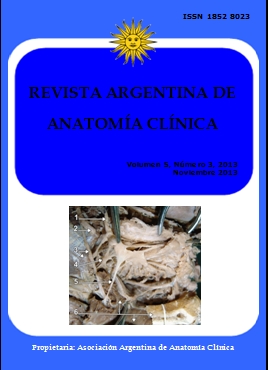CONCURRENT VARIATIONS IN THE FORMATION OF LATERAL CORD AND MEDIAN NERVE OF BRACHIAL PLEXUS. 208 Variaciones en la formación del cordón lateral y el nervio mediano del plexo braquial
DOI:
https://doi.org/10.31051/1852.8023.v5.n3.14077Palabras clave:
Anatomical variations, Lateral cord, Median nerve, variaciones anatómicas, cordón lateral, nervio medianoResumen
El cordón lateral y el nervio mediano se asocian a variaciones. Observamos variaciones simultáneas en la formación del cordón lateral y nervio mediano en treinta y dos cadáveres fijados en formol. En 29,6% de extremidades superiores el cordón lateral se formó por la división anterior del tronco superior solamente. En el 21,8% de estos casos la división anterior del tronco medio formó dos raíces adicionales para el nervio mediano y en 7,8% de los casos la división anterior del tronco medio se unió con la raíz medial del nervio mediano. En el 14% de las extremidades superiores no se formó la parte superior del tronco y el cordón lateral se formó por la unión de la división anterior de las raíces C5, C6 y C7. En 6.2% de esos casos donde no se formó la parte superior del tronco, el nervio mediano recibió una raíz adicional del cordón lateral. Creemos que el conocimiento previo de estas variaciones anatómicas es de interés para el anatomista y médico por igual. Los cirujanos que realizan procedimientos que implican neoplasias o reparar traumatismos necesitan ser conscientes de estas variaciones.
Lateral cord and median nerve are associated with variations. We observed concurrent variations in the formation of lateral cord and median nerve in thirty two formalin fixed cadavers. In 29.6% upper limbs Lateral cord was formed by anterior division of upper trunk only. In 21.8% of these cases the anterior division of middle trunk formed two additional roots for the median nerve and in 7.8% cases anterior division of middle trunk joined with medial root of median nerve. In 14% upper limbs the upper trunk was not formed and the lateral cord was formed by union of anterior division of C5, C6 and C7 roots. In 6.2% of such cases where upper trunk was not formed, the median nerve received an additional root from lateral cord. We believe that prior knowledge of such anatomical variations is of interest to the anatomist and clinician alike. Surgeons who perform procedures involving neoplasms or repairing trauma need to be aware of these variations.
Referencias
Chauhan R, Roy TS. 2002. Communication between median and musculocutaneous nerve-A case report. J Anat Soc India 51: 72-5.
Chitra R. 2007. Various types of inter-communications between musculocutaneous and median nerve-A analytical study. Ann Indian Acad Neurol 10: 100-4.
Keibel NZ, Mall FP. 1912. Nerves of the arm and leg In: Keibel NZ editor. 1st ed. Manual of human embryology. Philadelphia: J.B. Lippincott, 122-8.
Loukas M, Tubbs RS, Stewart D. 2008. An abnormal variation of the brachial plexus with potential clinical significance. West Indian Med J 57: 403-5.
Matejcik V. 2003. Aberrant formation and clinical picture of brachial plexus from the point of view of a neurosurgeon. Bratisl Lek Listy 104: 291-9.
Millar RA. 1932. Comprative studies upon the morphology and the distributions of the brachial plexus. Am J Anat 54: 143-75.
Nayak S. 2007. Absence of musculocutaneous nerve associated with clinically important variations in the formation, course and distribution of median nerve. Neuroanatomy 6: 49-50.
Orebaugh SL, Williams BA. 2009. Brachial plexus anatomy: normal and variant. Scientific World Journal 9: 300-12.
Pais D, Casal D, Santos A, O’neill JG. 2010. A variation in the origin of median nerve associated with unusual origin of the deep brachial artery. J Morphol Sci 27: 35-8.
Sannes HD, Reh TA, Harris WA. 2000. Development of nervous system. In; Axon growth and guidance. New York: Academic press, 189-97.
Sassoli Fazan VP, Sc Souza Amadeu A, Caleffi AL, Rodrigues Filho OA. 2003. Brachial plexus variations in its formation and main branches. Acta Cir Bras 18: 14-8.
Singla RK, Mahajan R, Sharma R, Sharma T. 2011. Bilateral non-formation of upper trunk of the brachial plexus with a unilateral communication between the musculo-cutaneous nerve and the median nerve: A case report. J Clin Diag Research 5: 1637-40.
Snell RS. 2004. Clinical anatomy by regions. 7th ed. Canada: Lippincott Williams and Wilkins.
Sontakke BR, Tarnekar AM, Waghmare JE, Ingole IV. 2011. An unusual case of an asymmetrical formation and distribution of median nerve. Int J Anat Var 4: 57-60.
Standring S, Berkowitz BKB, Hackney CM, Ruskell IGL. 2005. Gray’s Anatomy, The anatomical basis of clinical practice. 39th ed. New York: Churchill and Livingstone.
Stevens JH. 1988. Brachial plexus paralysis. Cli Orthop Relat Res 237: 4-8.
Sundaram SM, Kumar MSJ, Sethupathi BB, Nayak S, Krishnamurthy A. 2008. Split median nerve with variation in its common digital branch. Neuroanatomy 7: 15-6.
Uzun A, Bilgic S. 1999. Some variations in the formation of the brachial plexus in infants. Tr J of Med Sci 29: 573-7.
Venieratos D, Anagnostopoulou S. 1998. Classification of communications between the musculocutaneous and median nerve. Clin Anat 11: 327-31.
Villamere J, Goodwin S, Hincke M, Jalani A. 2009. A brachial plexus variation characterized by the absence of the superior trunk. Neuroanatomy 8: 4-6.
Descargas
Publicado
Número
Sección
Licencia
Los autores/as conservarán sus derechos de autor y garantizarán a la revista el derecho de primera publicación de su obra, el cuál estará simultáneamente sujeto a la Licencia de reconocimiento de Creative Commons que permite a terceros compartir la obra siempre que se indique su autor y su primera publicación en esta revista. Su utilización estará restringida a fines no comerciales.
Una vez aceptado el manuscrito para publicación, los autores deberán firmar la cesión de los derechos de impresión a la Asociación Argentina de Anatomía Clínica, a fin de poder editar, publicar y dar la mayor difusión al texto de la contribución.



